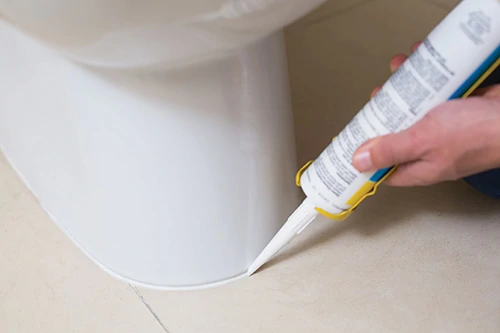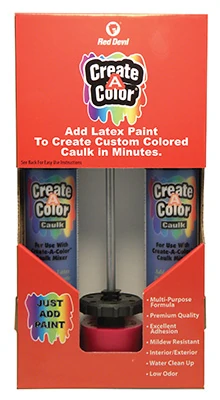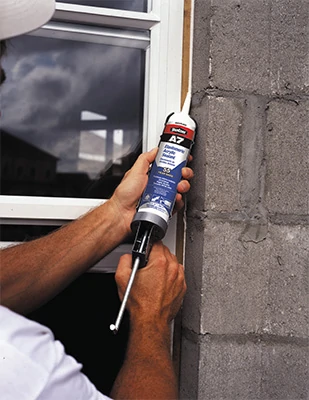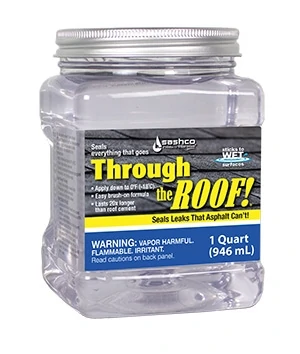Caulks are used to seal joints for a decorative finish, to seal joints to prevent water intrusion, or both. When it comes to sealing joints in crown molding or to weatherproofing windows, choosing the right caulk/sealant product is the first order of business.
Caulk/Sealant Selection
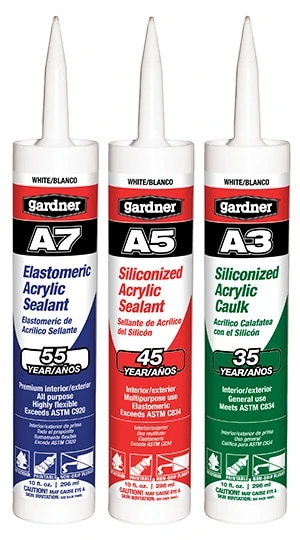
Silicone sealants have long been the staple for exterior projects where a waterproof seal is necessary. Silicone works well for use in the kitchen and bath. They can be purchased with antimicrobial additives to fight mold and mildew, and can be easily removed and replaced when the bead gets grimy.
However, standard silicone cannot be painted and is incredibly messy and sticky to use. Newer formulations of silicone-based sealants can be painted—but only if indicated on the packaging—so pay close attention when buying.
Acrylic caulk is only appropriate for interior projects and is not waterproof, nor is it very flexible and may crack over time. However, acrylic caulk can easily be painted and is much easier to tool and clean up than silicone. Standard acrylic caulk is cosmetic and not intended to serve as a sealant, but it is also the least expensive option.
Hybrid caulk/sealant products come in formulations containing some of the attributes of both silicone and acrylic, meaning they can be cleaned or tooled more easily, remain flexible, can be painted and still retain a waterproof seal.
Pro-grade polyurethane-based sealants are ideal for siding, windows and doors, because they stay flexible and don’t shrink, have better adhesion than silicone—plus, they’re paintable. Lexel is a high-quality sealant that utilizes liquefied rubber that even sticks to wet surfaces. These pro-grade sealants cost more but deliver excellent results. Water-based and solvent-based caulk/sealants complicate the selection even further, offering similar hybrid properties, and many serve double-duty as adhesives.
The easiest way to parse the many options is to pay close attention to the indications on the packaging, making sure they match the job at hand. Whether the product is flexible, waterproof, paintable, or contains a mildewcide additive, all features should be listed prominently on the label.
Crucial Features of a Caulk Gun
Caulk guns are relatively inexpensive tools, so it makes sense to pay just a little extra for a gun with the right features.
Spout Cutter. Every tube of caulk will need to have its spout clipped, and there’s no reason to lug around an extra pair of snips. Look for a gun with an integrated spout cutter typically located in the handle.
Seal Punch. This super-simple feature should come on every gun, but it doesn’t. It’s a small metal rod that flips out from beneath the gun to puncture the caulk tube’s interior seal, so you don’t have to monkey around with a wire coat-hanger or other makeshift implement.
Plunger Type. Caulk guns use one of two drive mechanisms: ratchet rod or smooth rod. Ratchet rods have visible teeth that are ratcheted forward by a drive arm when you pull the trigger. Smooth rods are driven by a spring-loaded pressure bar and generally have twice the thrust for smoother bead control and less hand fatigue. The smooth-rod variety usually costs more, however, and some have a tendency to wear out and slip when the trigger is pulled.
Pro Tips for Caulking Success
Remove Old Sealant. To remove a grungy bead of silicone for replacement, cut through each side of the bead with a utility knife and pull it away by hand. If you’re lucky, most of the bead will stay intact as a strip. To remove any remaining sealant, scrape it with a paint scraper held at a shallow angle. Finish up by scrubbing the surface with mineral spirits and an abrasive pad to get rid of any residue. Once clean and dry, apply a new bead.
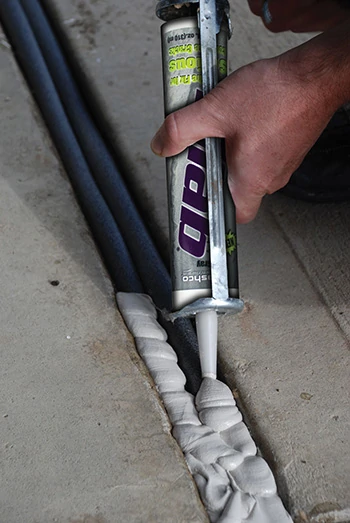
Seal Big Joints. To seal a joint larger than 1/4-in. wide, use a foam backer rod as a filler before applying the caulk. Less expensive than caulk, the rods provide a cheaper way to fill the empty space than using caulk alone. Plus, when caulk is applied over a backer rod, it forms an “hourglass” shape with large surface areas of adhesion at the sides of the joint. The hourglass shape of the caulk bead withstands joint movement better than any other configuration.

Caulk a Tub. When caulking a bathtub, first fill the tub with water. The weight will pull the tub downward, maximizing the size of the joint. Apply a flexible, waterproof caulking along the edge of the tub in full contact with both vertical and horizontal surfaces. This prevents future stress and cracking of the caulk joint. Once the bead is dry, drain the water.
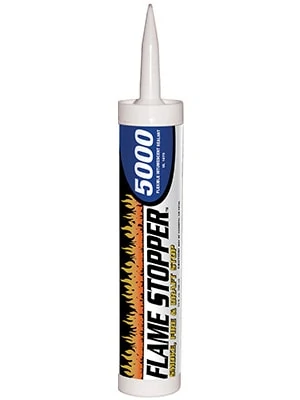
Specialty Caulk. Many formulations offer special properties specific to certain applications.
For example, Sashco’s Slab concrete crack repair caulk combines superior adhesion, elasticity and a granular texture to match the surrounding concrete. Flame Stopper 5000 from Gardner-Gibson expands when exposed to extreme heat, cutting off the spread of fire through penetrations. Create-a-Color from
Red Devil is a caulk that can be colored with latex paint to match the surrounding décor.
New Caulking Solutions
Tytan All-Purpose Silicone
Tytan All-Purpose Silicone is an innovative, versatile and cost-effective silicone designed for interior and exterior use. It is perfect for high-humidity environments since it offers a long-term watertight seal that won’t mold, mildew, discolor, slump or shrink.
It may also be used for sealing trim in both interior and exterior installations with its flexible seal. It won’t break down because of weather, UV radiation, or minor ware. It provides a strong seal and bond to most non-porous surfaces.
Big Stretch
Big Stretch by Sashco won’t crack, it just stretches. The original, high-performance elastic sealant, Big Stretch is great for windows, doors, siding and molding. It can span a gap up to 2 inches and stretch up to 500 percent to withstand joint movement. Big Stretch eliminates cracked caulking and returns to shape with memory recovery. Visit sashco.com.
Mor-Flexx
Mor-Flexx looks like mortar but stretches like rubber. It’s textured to match mortar, concrete or stucco, and paintable and easy to cleanup with water. Use it in-between bricks and stone to replace cracked or missing mortar. Mor-Flexx is available in beige or gray. It’s a time-tested product that spans gaps up to 3 inches and now comes with a new label. Visit sashco.com.
Create-a-Color Caulk Kit
Red Devil’s Create-A-Color Caulk Kit makes it easy for DIY’ers or contractors to create a caulk color to match just about any interior or exterior design element—saying goodbye to plain old white, with endless possibilities. The proprietary caulk blend bonds with ordinary latex paint rather than repelling it like standard caulks. The kit includes a Standard Caulk Mixer; two tubes of specially formulated Create-A-Color Caulk, a syringe for injecting the paint and an easy-to-follow instruction guide. The system works in minutes to create the perfect color and can then be applied with a standard caulk gun. (Note: the mixer is not a caulk gun and is for mixing only). Pros can also purchase a heavy-duty metal caulk mixer separately for daily use on the job. The mixers are very easy to clean and re-use. The Create-A-Color Caulk is a quality formulation that has excellent adhesion, mildew-resistance, interior and exterior performance, low odor and water cleanup. Visit www.reddevil.com.
Eterna-Kote
For roofing work and more, Eterna-Kote Silicone+ S-1 Roof Sealant is a white rubber sealant that provides the “ultimate” waterproofing protection from the elements. This product has exceptional adhesion and flexibility and is compatible with most building materials. Eterna-Kote is ideal for roof repairs, or on new installations of skylights, windows, doors or vents. In hot or cold climates, this waterproof seal will permanently stretch to prevent cracking and peeling, and the cured seal-ant is mold and mildew resistant. Visit www.gardner-gibson.com.
Through the Roof
Sashco introduces the new Clear Quart package for Through the Roof. Moving from the can quart to the clear quart, users can now see that the product inside is crystal clear. It’s also easier to handle with a molded side that fits in your hand. The container can be resealed and is very durable and sturdy. The product “seals everything that goes Through the Roof.” You can apply it down to zero degrees, in standing water, on wet surfaces, and it sticks to a variety of roof implements. Its easy brush-on formula lasts 20 times longer than roof cement, and it seals leaks permanently. Also available in one-gallon containers and cartridge-grade. The clear quart is not available in California, but Sascho does offer the cartridge, can quart and gallon in a VOC formula for California. Visit sashco.com.


